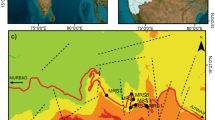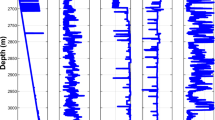Abstract
In view of the dynamic instability of rock mass in high geostress areas during underground engineering excavation, the comprehensive weight and extension methods are adopted to research the rockburst prediction. Firstly, five main influencing factors including uniaxial compressive strength, stress coefficient, brittleness coefficient, elastic energy index, and integrity of rock mass are used as the evaluation indexes of rockburst prediction according to the conditions required for rockburst occurrence. The assessment index system of rockburst intensity is constituted. Secondly, the analytic hierarchy process (AHP) and variation coefficient methods are used to determine the comprehensive weight of evaluation index, and the rockburst prediction model is established based on the extension evaluation method. Thirdly, the parameter programming and numerical calculation of the proposed prediction model are carried out in the MATLAB software. The user visualization execution window and software system of rockburst prediction model are realized. Finally, the software system is applied to the rockburst prediction in the water diversion tunnels of Jiangbian hydropower station and Jinping secondary hydropower station. The prediction results are compared with the actual situation and other evaluation methods. The results show that (i) the establishment of the user visualization window realizes the visualization and systematization of rockburst prediction model, which improves the data import rate and calculation efficiency. (ii) The prediction results of the proposed software system agree well with the actual situation, and they are more accurate than other evaluation methods. (iii) The proposed software system of rockburst prediction can also be used in coal mine, metro, and other underground projects, which has good engineering application values.








Similar content being viewed by others
References
Adoko AC, Gokceoglu C, Wu L, Zuo QJ (2013) Knowledge-based and data-driven fuzzy modeling for rockburst prediction. Int J Rock Mech Min Sci 61:86–95
Afraei S, Shahriar K, Madani SH (2018) Statistical assessment of rock burst potential and contributions of considered predictor variables in the task. Tunn Undergr Space Technol 72:250–271
Afraei S, Shahriar K, Madani SH (2019) Developing intelligent classification models for rock burst prediction after recognizing significant predictor variables, Section 1: Literature review and data preprocessing procedure. Tunn Undergr Space Technol 83:324–353
Cai M (2016) Prediction and prevention of rockburst in metal mines – a case study of Sanshandao gold mine. J Rock Mech Geotech Eng 8(2):204–211
Cai W (1998) Extenics overview. Syst Eng-Theory Pract 18(1):76–84
Cai W, Dou LM, Zhang M, Cao WZ, Shi JQ, Feng LF (2018) A fuzzy comprehensive evaluation methodology for rock burst forecasting using microseismic monitoring. Tunn Undergr Space Technol 80:232–245
Cai W, Yang CY (2013) Basic theory and methodology on extenics. Chin Sci Bull 58(13):1190–1199
Chen HJ, Li NH, Nie DX, Shang YQ (2002) A model for prediction of rockburst by artificial neural network. Chin J Geotech Eng 24(2):229–232
Dong L, Li X, Peng K (2013) Prediction of rockburst classification using Random Forest. Trans Nonferrous Metals Soc China 23(2):472–477
Feng GL, Feng XT, Xiao YX, Yao ZB, Hu L, Niu WJ, Li T (2019) Characteristic microseismicity during the development process of intermittent rockburst in a deep railway tunnel. Int J Rock Mech Min Sci 124:104135
Gao W (2014) Forecasting of rockbursts in deep underground engineering based on abstraction ant colony clustering algorithm. Nat Hazards 76(3):1625–1649
Gong FQ, Luo Y, Li XB, Si XF, Tao M (2018a) Experimental simulation investigation on rockburst induced by spalling failure in deep circular tunnels. Tunn Undergr Space Technol 81:413–427
Gong FQ, Si XF, Li XB, Wang SY (2018b) Experimental investigation of strain rockburst in circular caverns under deep three-dimensional high-stress conditions. Rock Mech Rock Eng 52:1459–1474
Gong S, Li J, Ju F, Dou L, He J, Tian X (2019) Passive seismic tomography for rockburst risk identification based on adaptive-grid method. Tunn Undergr Space Technol 86:198–208
Hao J, Shi KB, Wang XL, Bai XJ, Chen JM (2016) Application of cloud model to rating of rockburst based on rough set of FCM algorithm. Rock Soil Mech 37(3):859–866 +874
He J, Dou L, Gong S, Li J, Ma Z (2017) Rock burst assessment and prediction by dynamic and static stress analysis based on micro-seismic monitoring. Int J Rock Mech Min Sci 93:46–53
He M, Ren FQ, Liu DQ (2018) Rockburst mechanism research and its control. Int J Min Sci Technol 28(5):829–837
Jia QJ, Wu L, Chen CH, Peng YX (2019) The comprehensive prediction model of rockburst tendency in tunnel based on optimized unascertained measure theory. Geotech Geol Eng 37(4):3399–3411
Jia YP, Lu Q, Shang YQ (2013) Rockburst prediction using particle swarm optimization algorithm and general regression neural network. Chin J Rock Mech Eng 32(2):343–348
Jiang Q, Feng XT, Xiang TB, Su GS (2010) Rockburst characteristics and numerical simulation based on a new energy index: a case study of a tunnel at 2,500 m depth. Bull Eng Geol Environ 69(3):381–388
Li CC, Mikula P, Simser B, Hebblewhite B, Joughin W, Feng XW, Xu NW (2019) Discussions on rockburst and dynamic ground support in deep mines. J Rock Mech Geotech Eng 11(05):1110–1118
Li N, Feng X, Jimenez R (2017a) Predicting rock burst hazard with incomplete data using Bayesian networks. Tunn Undergr Space Technol 61:61–70
Li N, Wang LG, Jia MT (2017b) Rockburst prediction based on rough set theory and support vector machine. J Central South Univ (Sci Technol) 48(5):1268–1275
Li SJ, Feng XT, Li ZH, Chen BR, Zhang CQ, Zhou H (2012) In situ monitoring of rockburst nucleation and evolution in the deeply buried tunnels of Jinping II hydropower station. Eng Geol 137:85–96
Li T, Cai MF, Cai M (2007) A review of mining-induced seismicity in China. Int J Rock Mech Min Sci 44(8):1149–1171
Li XB, Gong FQ, Tao M, Dong LJ, Du K, Ma CD, Zhou ZL, Yin TB (2017c) Failure mechanism and coupled static-dynamic loading theory in deep hard rock mining: a review. J Rock Mech Geotech Eng 9(4):767–782
Liang WZ, Zhao GY, Wu H, Dai B (2019) Risk assessment of rockburst via an extended MABAC method under fuzzy environment. Tunn Undergr Space Technol 83:533–544
Mansurov VA (2001) Prediction of rockbursts by analysis of induced seismicity data. Int J Rock Mech Min Sci 38(6):893–901
Masoudi R, Sharifzadeh M (2018) Reinforcement selection for deep and high-stress tunnels at preliminary design stages using ground demand and support capacity approach. Int J Min Sci Technol 28(4):573–582
Meng FZ, Zhou H, Wang ZQ, Zhang LM, Kong L, Li SJ, Zhang LM, Hu SC (2017) Experimental study of factors affecting fault slip rockbursts in deeply buried hard rock tunnels. Bull Eng Geol Environ 76(3):1167–1182
Miao SJ, Cai MF, Guo QF, Huang ZJ (2016) Rock burst prediction based on in-situ stress and energy accumulation theory. Int J Rock Mech Min Sci 83:86–94
Qiu DH, Chen JP, Zhang BH (2006) Study on rockburst prediction and prevention in deep and over-length highway tunnel. Chin J Underground Space Eng 2(6):950–955 +961
Shirani Faradonbeh R, Taheri A (2018) Long-term prediction of rockburst hazard in deep underground openings using three robust data mining techniques. Eng Comput 35(2):659–675
Tang CA, Kaiser PK (1998) Numerical simulation of cumulative damage and seismic energy release in unstable failure of brittle rock--Part I. Fundament Intl J Rock Mech Mining Sci 35(2):113–121
Vaidya OS, Kumar S (2006) Analytic hierarchy process: an overview of applications. Eur J Oper Res 169(1):1–29
Wang G, Gong S, Dou L, Cai W, Yuan X, Fan C (2019) Rockburst mechanism and control in coal seam with both syncline and hard strata. Saf Sci 115:320–328
Wang JA, Park HD (2001) Comprehensive prediction of rockburst based on analysis of strain energy in rocks. Tunn Undergr Space Technol 16(1):49–57
Wang JL, Chen JP, Y J, Que JS (2009) Method of distance discriminate analysis for determination of classification of rock burst. Rock Soil Mech 30(7):2203–2208
Wang XF (2006) Study on rockburst simulation and prediction of deep buried super long diversion tunnel of Jinping II hydroelectric power station (master thesis). Chengdu University of technology
Wen CP (2008) Application of attribute synthetic evaluation system in prediction of possibility and classification. Eng Mech 06:153–158
Xue YG, Li ZQ, Li SC, Qiu DH, Tao YF, Wang L, Yang WM, Zhang K (2019) Prediction of rock burst in underground caverns based on rough set and extensible comprehensive evaluation. Bull Eng Geol Environ 78(1):417–429
Yan ZX, H X, G B (2013) Study of PLS-LCF model for rock burst prediction based on particle swarm optimization. Chin J Rock Mech Eng 32(supp.2):3180–3186
Zhang CQ, Feng XT, Zhou H, Qiu SL, Wu WP (2013) Rockmass damage development following two extremely intense rockbursts in deep tunnels at Jinping II hydropower station, southwestern China. Bull Eng Geol Environ 72(2):237–247
Zhang JF, Jiang FX, Yang JB, Bai WS, Zhang L (2017) Rockburst mechanism in soft coal seam within deep coal mines. Int J Min Sci Technol 27(3):551–556
Zhou H, Meng FZ, Zhang CQ, Hu DW, Yang FJ, Lu JJ (2015) Analysis of rockburst mechanisms induced by structural planes in deep tunnels. Bull Eng Geol Environ 74(4):1435–1451
Zhou J, Li X, Mitri HS (2016) Classification of rockburst in underground projects: comparison of ten supervised learning methods. J Comput Civ Eng 30(5):04016003
Zhou J, Li X, Shi X (2012) Long-term prediction model of rockburst in underground openings using heuristic algorithms and support vector machines. Saf Sci 50(4):629–644
Funding
We would like to acknowledge the financial support from the China Postdoctoral Science Foundation (Grant No.: 2019M652384), the National Natural Science Foundation of China (Grant No.: 41977222), and the Open Research Fund of State Key Laboratory of Geomechanics and Geotechnical Engineering, Institute of Rock and Soil Mechanics, Chinese Academy of Sciences, (Grant No.: Z019009).
Author information
Authors and Affiliations
Corresponding author
Rights and permissions
About this article
Cite this article
Zhang, L., Zhang, X., Wu, J. et al. Rockburst prediction model based on comprehensive weight and extension methods and its engineering application. Bull Eng Geol Environ 79, 4891–4903 (2020). https://doi.org/10.1007/s10064-020-01861-4
Received:
Accepted:
Published:
Issue Date:
DOI: https://doi.org/10.1007/s10064-020-01861-4




